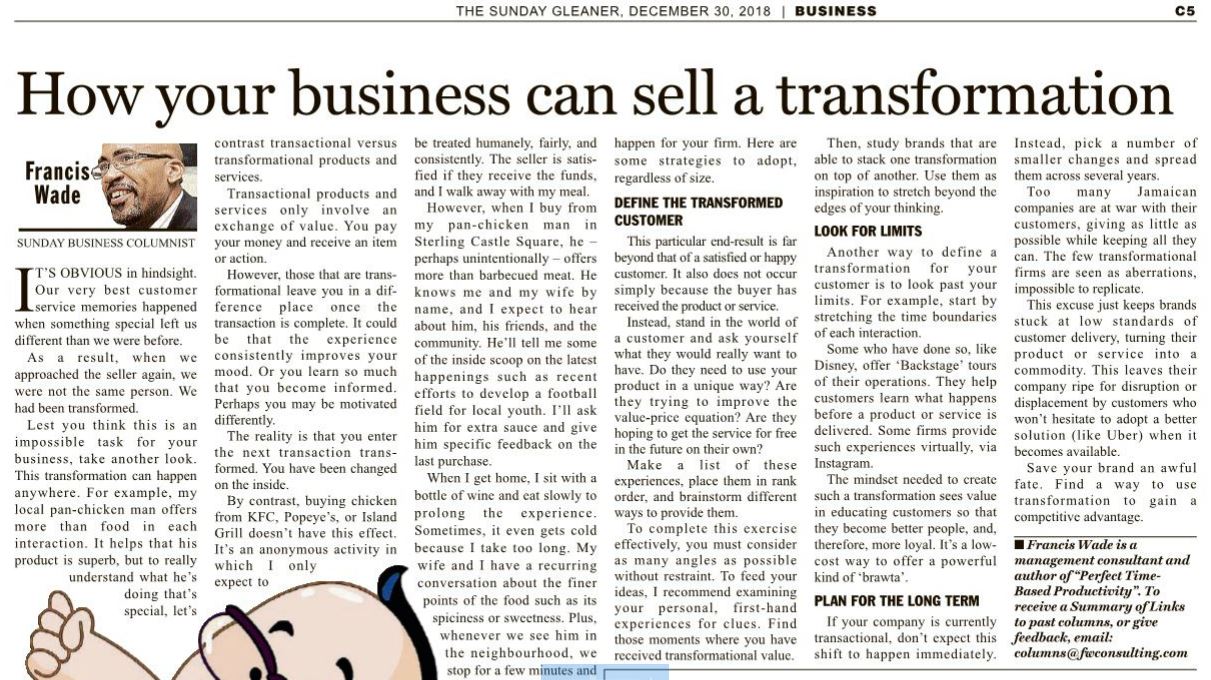It’s obvious in hindsight. Our very best customer service memories happened when something special left us different than we were before. As a result, when we approached the seller again, we were not the same person: we had been transformed.
Lest you think it’s this is an impossible task for your business, take another look. This transformation can happen anywhere. For example, my local pan-chicken man offers more than food in each interaction. It helps that his product is superb, but to really understand what he’s doing that’s special, let’s contrast transactional versus transformational products and services.
Transactional products and services only involve an exchange of value. You pay your money and receive an item or action.
However, those which are transformational leave you in a difference place once the transaction is complete. It could be that the experience consistently improves your mood. Or you learn so much that you become informed. Perhaps you may be motivated differently.
The reality is that you enter the next transaction transformed. You have been changed on the inside.
By contrast, buying chicken from KFC, Popeye’s or Island Grill doesn’t have this effect. It’s an anonymous activity in which I only expect to be treated humanely, fairly and consistently. The seller is satisfied if they receive the funds, and I walk away with my meal.
However, when I buy from my pan-chicken man in Sterling Castle Square, he (perhaps unintentionally) offers more than barbecued meat. He knows my wife and I by name and and I expect to hear about him, his friends and the community. He’ll tell me some of the inside scoop on the latest happenings, such as recent efforts to develop a football field for local youth. I’ll ask him for extra sauce and give him specific feedback on the last purchase.
When I get home, I sit with a bottle of wine and eat slowly to prolong the experience. Sometimes, it even gets cold because I take too long. My wife and I have a recurring conversation about the finer points of the food, such as its spiciness, or sweetness. Plus, whenever we see him in the neighborhood we stop for a few minutes and have a chat.
It’s tempting to believe that a big business can’t be transformational. However, I worked for a world-leading training company that delivered transformation in 200-person workshops in dozens of countrues, making me think it can happen for your firm. Here are some strategies to adapt, regardless of size.
1. Define “The Transformed Customer”
This particular end-result is far beyond that of a satisfied or happy customer. It also does not occur simply because the buyer has received the product or service.
Instead, stand in the world of a customer and ask yourself what they would really want to have. Do they need to use your product in a unique way? Are they trying to improve the value-price equation? Are they hoping to get the service for free in the future on their own?
Make a list of these experiences, place them in rank order and brainstorm different ways to provide them.
To complete this exercise effectively, you must consider as many angles as possible without restraint. To feed your ideas, I recommend examining your personal, first-hand experiences for clues. Find those moments where you have received transformational value.
Then, study brands which are able to stack one transformation on top of another. Use them as inspiration to stretch beyond the edges of your thinking.
2. Look for Limits
Another way define a transformation for your customer is to look past your limits. For example, start by stretching the time boundaries of each interaction.
Some who have done so, like Disney, offer “Backstage” tours of their operations. They help customers learn what happens before a product or service is delivered. (Some firms are delivering such experiences virtually, via Instagram.)
The mindset needed to create such a transformation sees value in educating customers so that they become better people, and therefore more loyal. It’s a low cost way to offer a powerful kind of “Brawta.”
3. Plan for the Long-Term
If your company is currently transactional, don’t expect this shift to happen immediately. Instead, pick a number of smaller changes and spread them across several years.
Too many Jamaican companies are at war with their customers, giving as little as possible while keeping all they can. The few transformational firms are seen as aberrations, impossible to replicate.
This excuse just keeps brands stuck at low standards of customer delivery, turning their product or service into a commodity. This leaves their company ripe for disruption or displacement by customers who won’t hesitate to adopt a better solution (like Uber) when it becomes available.
Save your brand an awful fate: find a way to use transformation to gain a competitive advantage.

